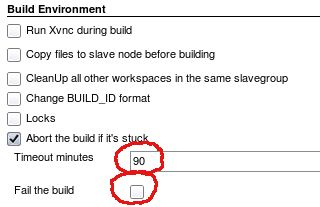Notice: This Wiki is now read only and edits are no longer possible. Please see: https://gitlab.eclipse.org/eclipsefdn/helpdesk/-/wikis/Wiki-shutdown-plan for the plan.
CI best practices
Continuous Integration - best practices
General tips
- keep the builds and tests fast!
- true to the XP spirit, turnaround time between check in and feedback (build successful/failed) should be kept to a minimum
- long running builds and tests should be split up
- eg. into staged tests: test a few basic things first and only if they are successful, run more detailed tests
- a CI server is not a build artifact repository or storage server!
- build artifacts in general should be seen as ephemeral
- if a build artifact is considered a milestone, release candidate, release, etc. it should be copied to a storage server (eg. downloads.eclipse.org)
- public announcements like "You can get the latest release from our Jenkins instance" are considered to be bad practice
Jenkins
Job configuration smells
- build logic leaks to job
- too many build steps
- shell steps
- not under SCM
Source: https://narkisr.github.io/jenkins-scaling/#configuration-smells
Deal with branches
- managing branches from UI results in duplication, create a template project and clone, use programmatic API instead
Job timeouts
- reasonable timeouts should be set to avoid long blocking builds (several hours or days)
pipeline { options { timeout(time: 30, unit: 'MINUTES') } stages { .. } // .. }
Periodical builds (nightly builds)
- instead of building a job every night at 12am whether or not code has changed, it's recommended to poll the SCM for changes instead (or even better, trigger jobs from webhooks)
- Job config -> Build Triggers -> Poll SCM
- to avoid load spikes and distribute load more evenly, it's recommended to use a cron definition like
H H(0-3) * * *(build is triggered sometime between 12AM and 3AM)
- to avoid load spikes and distribute load more evenly, it's recommended to use a cron definition like
- Job config -> Build Triggers -> Poll SCM
Disk usage
Builds and tests can consume large amounts of data while checking out Git repositories, downloading Maven artifacts and compiling multi-OS, multi-arch, multi-bitness artifacts, etc.
Disk space is cheap, but not free (yet). Therefore disk usage should be reasonable.
Here is a rough guideline for JIPPs:
- up to 50GB of disk space is considered to be fine.
- 50-100GB is mostly considered to be OK, if it has no impact on other projects.
- upwards of 100GB is considered to be excessive and you should check your job structure/configurations
As always there are exceptions to that rule. If a project has good reasons to use a lot of disk space this will be respected.
If not, you will be notified and ultimately blamed publicly.
Build history
- a build history is a good indicator to track the health/stability/test coverage, etc. of your project
- since the build history can take up considerable large amounts of disk space it should be kept at bay
- it's nice to see the last 500 builds, but in many cases 10-20 builds have nearly the same value to see trends
- in most cases there is no benefit in keeping more than a few builds with their artifacts, especially if the size is in the 500MB+ range
- The relevant setting in Jenkins job configurations is Max # of builds to keep with artifacts, this should be kept between 2 and 5, depending on the size of the artifacts (bigger artifacts -> keep less builds)
Console logs
- console logs are important, but if all debug levels are dialed to 11, logs can become quite big (100s of MB)
- browsers in general don't like huge console logs
- try to find a balance between huge logs and time spent to run a build again with different logging levels if something failed (maybe a log level parameter can help)
Workspace
- workspaces should be cleaned before the build starts to avoid old/changed files influencing new builds
- Job config -> Build Environment -> Delete workspace before build starts
- workspaces can also be cleaned when a build is done
- this is mostly useful for jobs with huge workspaces, where accessing the workspace for debugging purpose is only rarely required
- Job config -> Post-build Actions -> Delete workspace when build is done
Keep this build forever
- this option should only be used in special circumstances and only for a very limited period of time
- this option should not be used to store the build artifacts (e.g. of a special build, like a release) for an extended period of time
- instead the build artifacts should be copied/moved to the project's directory on download.eclipse.org
Old build jobs
- best case scenario: all your build configurations are stored in a SCM and you don't have to keep extra job configurations
- if a build job is deprecated or archived, consider deleting the workspace to save disk space

